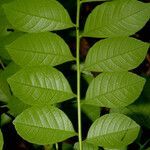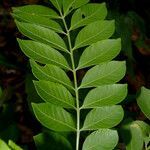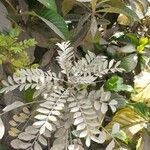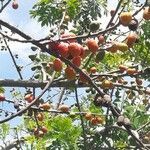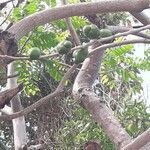Tree up to 10(-25) m high and 30(-80) cm ø. Buttresses absent. Bark greyish or brown, smooth. Leaves 4-12 pairs; rachis 6-12 cm, petiole 2½-4 cm, both puberulous. Leaflets chartaceous, obliquely elliptic or elliptic-oblong, 2-5½ by 1-2½ cm; puberulous on the midrib, nerves and veins below, and on the midrib above, glabrescent; base obliquely cuneate; apex acute to acuminate; margin obscurely crenulate especially at the upper half, or entire; nerves 6-10 pairs, joining with an intramarginal vein; veins reticulate; petiolules short, ¼-½ cm, the terminal one c. ¾ cm. Inflorescences appearing before the leaves, paniculate or racemiform, axillary, up to 4 cm long, slightly puberulous; branches c. 1 cm long, few-flowered; floral bracts 1—1½ mm long; pedicels 2-4 mm. Flowers reddish or purplish. Calyx lobes triangular, c. ½ mm long. Petals ovate-oblong, 3-4 by 1½-2 mm. Stamens 3 mm; anthers ovoid, c. ½ mm long. Disk shortly cupular, c. 1 mm ø. Ovary subglobose, c. ¾ mm ø, 5-(or 4-)celled; styles 5 (or 4), free, c. ¾ mm. Drupe (fresh) oblong, obovoid, or ovoid, 2½-4 by 2 cm, purple-red or dark purple, or yellow (cultivar) when ripe; scars of styles 5 (or 4), lateral, at the apical end. Flanges of the endocarp (with fibrous processes) partly or wholly and directly connected with a peripheral layer of meshes, sometimes with cavities alternating with loculi (shown in a median, transverse section).
A medium sized tree. It grows 4-10 m high. It has an irregular trunk and broad crown. Often it is low and sprawling. It loses its leaves during the year. The leaves are made up of 5-12 pairs of leaflets. The leaflets are 2-4 cm long and they fall before flowering. The flowers are red and in groups 3-5 cm long. They are on the small branches. The fruit are small and red and sub-acid. They are round or oval and 2.5-5 cm long. They often grow in clusters of three. The fruit is edible. The fruit has a woody kernel which contains the seed. The flesh is creamy-yellow.
